1700
In 1700, the Meherrin were included in an attempt to negotiate a peace with “foreign Indians” (Document B-6).
(The Secret History of the Meherrin page 76)
1700
In May 1700 the gentlemen of the Nottoway, Meherrin, Nansemond, Chickahominy,
Rappahannock and Nanzattico Indians, tribes that were tributaries to the Crown, met with the governor and his council at Jamestown, where they were interrogated about a treaty they wanted to make with some “foreign” or non-Virginia Indians. The Tributaries agreed to deliver to the governor the wampum-peake (or shell) belts they expected to receive when the treaty was consummated. He, in turn, would retain the belts until the next time the Indians delivered their annual tribute. The wording of the dialogue between the governor and the Indians indicates that Jamestown was the site at which the Tributary tribes traditionally presented their annual tribute (Sainsbury et al. 1964:18:79).
COLONIAL (National Park Service)
A Study of Virginia Indians and Jamestown: The First Century
CHAPTER 4:
Narrative History
Martha W. McCartney
1700
In May 1700 the gentlemen of the Nottoway, Meherrin, Nansemond, Chickahominy, Rappahannock and Nanzattico Indians, tribes that were tributaries to the Crown, met with the governor and his council at Jamestown, where they were interrogated about a treaty they wanted to make with some “foreign” or non-Virginia Indians. The Tributaries agreed to deliver to the governor the wampum-peake (or shell) belts they expected to receive when the treaty was consummated. He, in turn, would retain the belts until the next time the Indians delivered their annual tribute. The wording of the dialogue between the governor and the Indians indicates that Jamestown was the site at which the Tributary tribes traditionally presented their annual tribute
(Sainsbury et al. 1964:18:79).
1702
Census of 1702 (Document B-7) The Meherrin are reported with 60 bowmen, or 210 people.
(The Secret History of the Meherrin page 78)
1703
In 1703, a party of seven in a bark boat was sighted on the Meherrin River, which the Meherrin assumed to be Seneca. The Meherrin attacked and killed five men who then turned out to be English (Document B-9).
(The Secret History of the Meherrin page 73)
1703
April 24th, 1703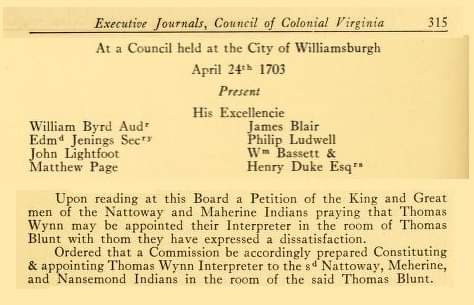
1703
“Whereas Coll. Thomas Godwin Commander in cheif of the Militia in Nansemd County hath informed his Excellcy that the Maherine Indians having discovered a bark boat coming down the Maherine River with about seven men in it, the said Indians supposing th an to be Spyes come from the Senequa Indians laid wait and killed five of the men in the said boat, the other two making their escape, but when the said Indians came up to the Boat they found the Slain
to be white men having sevll English goods with them.”
Virginia Executive Journals of Council (Mcllwaine) II: 323. June 17,1703.
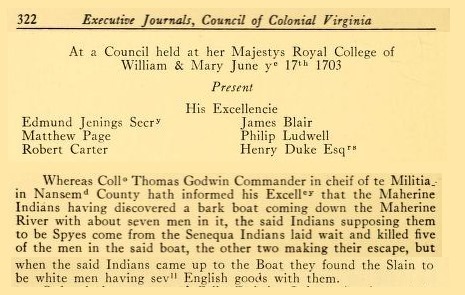
1703
“As to what y ’u desire to know off ye Ind’s, some are Civil & some barbarous, they using ye Seabord. They live in small Townes and barke Cabbins, pallisado’d in w ’th 2 or 3 Rows of Stakes; every Towne or nation has its particular King & different language; they have some notion of ye Flood, butt verry obscure. They off ye First Fruits o f everything they eat to ye Devil, by whome they cure deseases & act severall strainge things, as laying ye wind, &c. Ye nations I am as yett acquainted with are, the Portes, Leites, Nazimumbs, Choans, Maherins, Pampticoughs, Bay Rivers, Marchipoongs, News Rivers, Cores, Corennines, Connomocksocks, w ’th all w ’ch (ye Cores & Corennines excepted) & ye Tuscaroorays, have verry Free commerce w ’th.”
North Carolina State Records (Saunders et al.) XXII: 734-735. August 5,1703. Letter from William Gale to his father
1703
C. Indian Land Grabbing
1. Causes of Tuscarora War
Calendar of State Papers Colonial, America and West Indies
Williamsbourg April 24, 1703 Upon reading a letter from Henderson Walker, President of North Carolina, complaining that the Maherine Indians do daily commit great injuries to the inhabitants of that province by destroying their stocks and burning their timber and houses, refusing to pay tribute or render obedience to that Government upon pretence that they are tributaries to this H.M. Colony and Dominion, altho’ their living is amongst the inhabitants of North Carolina, it is the opinion of the Council that it doth not appear that the said Maherine Indians live within the bounds of Carolina, but have always been reputed tributaries and paid tribute to this Government as living under the same, and therefore the Province of North Carolina hath no pretence of demanding tribute of them, but if any injuries or outrages have been or shall be committed by them, upon due proof thereof, H.E. and Council will take suitable measures for furnishing them, and giving all reasonable satisfaction to the inhabitants of North Carolina.
Thomas Wynn was appointed Interpreter to the Nattoway, Maherine and Nansemond Indians in the room of Thomas Blunt, with whom they have expressed dissatisfaction.
Whereas the Nansemond Indians have made application to H.E. that no person may be allowed to take up land below a place called the Bean Swamp adjacent to their land, Ordered that Thomas Wynn enquire what and how much land the said Indians now possess, and what quantity of land there is below the Bean Swamp.
Whereas the Nattoway Indians have made complaint that the English inhabitants daily take up land and seat nigher to their towns, so that in a short time they will have no room either for their stocks or hunting, and praying that none may be permitted to seat nigher to their town than at present, and also complaining that William May of Isle of Wight County hath surveyed a Plantation belonging to them on the Nattoway Swamp, ordered that the Interpreter inquire into the matter.
Complaint being made by the Nattoway Indians that the inhabitants of this Colony carrying rum into their town may prove of very dangerous consequence by reason that many of their men getting drunk therewith may at such times be made an easy prey to any strange Indians who shall invade them, H.E. by advice of the Council doth hereby strictly forbid all persons whatsoever to carry any rum or other strong liquor into the Nattoway Town, upon pain of suffering such punishment as may justly be inflicted on them for their offending in a matter of such pernicious consequence. A copy of this Order to be published by the Sheriffs.70
(Colonial Native Dispossession of North Carolina Researched by: Baylus C. Brooks Research Assistant: Julie S. Brook. Page 45-46)

1703
In 1703 a party of Meherrins mistakenly killed a few French refugees who had settled at the old Monacan town site, this was judged by the council as an accident. The French were warned against “straggling” in the woods, and the Meherrins were not punished for the crime.
Ibid., 2: 322-3.
1703
Carolina colonists, complained to the Virginia Government, accusing Meherrins of “destroying their stocks and burning their timber and houses, refusing to pay tribute or render obedience to that Government.” These reports were never substantiated, and Virginia said that they would handle any further complaints against the Meherrin. The Meherrin denied ever harming colonials’ homes or property.
(Lefler and Powel, “Colonial North Carolina”)
1703
A 1703 petition from North Carolina regarding the Meherrin presence
in “their” territory, opened the eyes of the Virginia oligarchs. Upon reading a letter from Henderson Walker Esqr. President of the Province of North Carolina complaining that the Maherine Indians do daily commit! great injuiys to the Inhabitants of that Province by destroying their Stocks and burning their timber and houses, refusing to pay Tribute or render obedience to that Government upon pretence that they are Tributarys to this her Majesty* Colony and Dominion, altho their living is amongst the Inhabitants of the Province of North Carolina. It is the opinion of the honorable Council that it doth not appear that the said Maherine Indians live within the bounds of the Province of Carolina, but that the said Indians have always been reputed Tributary* and have accordingly paid Tribute to this Government as living under the same, And therefore the Province of North Carolina hath no pretence of demanding Tribute of them…
(Mcllwaine, Vol. 11:314-316).
Apparently, communication was so poor between the colonies that North Carolina was not even aware of the royal treaty signed by the Meherrin. The Meherrin were defiantly defending a homeland that had been sanctioned by colonial decree. Their notoriously fierce spirit had obviously not been dampened by their displacement into North Carolina.
(The Secret History of the Meherrin page 73)
1704
The Virginia Colony again interfered in the soverign affairs of Indian nations by preventing peace treaties among them:
“Application being made to His Excellency by the Nattoway, Meherine, Nansemond, Pamunkie, Chicahominy and Nansiatico Indians that two men of each of said Nations may have leave to go to the Northward to conclude a Peace with the Senequas, and that likewise two men of the Tuscoruro Indians may be included in the pass to be granted for that purpose, and also that they may endeavour the ransoming of the Nattoway King taken last summer as they suppose by the said Senequa Indians or some others living to the northward; It is the opinion of his Excellency and the Council that it is not convenient to suffer the said Indians to go further Northward than the Northern limits of this government but if they can accomplish their intentions without proceeding further than this Government extends that they then be permitted to go so far, they taking with them as Interpreters Capt Joshua Wynne, Captain Thomas Wynn or Mr. James Adams or any one or two of them, which interpreter or interpreters they are to permit, & he & they are hereby also directed to be present at all the consultations that shall be had by the same Indians with any strange Indians, and without whose consent and approbation they are to conclude nothing.
And the said Indians and Interpreter or Interpreters are strictly required to take care at the said meeting with any strange Indians nothing be treated or concluded that may tend to the Prejudice of this Her Majestys Colony or Inhabitants thereof as they will answer the contrary.
And in case the said Interpreters shall perceive that said Indians intend to conclude anything contrary to the true intent and meaning hereof, they are required to use their upmost endeavors to prevent the same, and to acquaint His Excellency of all their proceedings. Upon Wch Restrictions & Limitations it is ordered that a pass be prepared under the Seal of the Colony for two of each Nation of the said Indians to go to the Northern bounds of this Government with their Interpreter without any molestations.
And ordered that a copy of this order be sent to the interpreter who shall be chosen to go with the said Indians for his and their better direction in the premises.”
“(Executive Journals of the Council of Colonial Virginia, Aug 3, 1699- April 27, 1705, Vol. II, P. 381 ( The Virginia State Library 1927 )”
1704

1704
That the Interpreter to the Nattoway and Maherin Indians acquaint the said Indians that the Council having received Information of a barbarous murder committed by the Nansiatico Indians on Rappannock river, and being apprehensive that some Forreign Indians may be in Confederacy with them who may probably attempt to do further mischief on our Frontiers, have thought fitt to informe them thereof, Requiring them to be as dilligent as may be to discover any strange Indians that may happen to come on the Frontiers, have thought fitt to informe them thereof, Requiring them to be as dilligent as may be to discover any strange Indians that may happen to come on the Frontiers o f this Colony, and forthwith to informe the honble Mr. President Byrd or Collo. Beja Harrison thereof and to be aiding and assisting to the Officers o f the Militia in apprehending any of the said Indians
Virginia Executive Journals of Council (Mcllwaine) II: 385. September 12, 1704
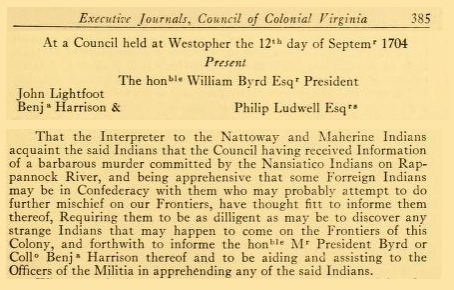
1704
Ordered that the Interpreter to the Maherine, Nattoway & Nansemond Indians and the Interpreter to the Pamunky & Chicahominy Indians attend the Commrs of Oyer and Terminer for trial of the Nansiatico Indians at Richmond County Court house on the fifth day of October next, and be assisting at the sd Trial as they shal be directed by the said Commrs. And it is further Ordered that the said Interpreters take with them two or three of the great men of each of the respective Nations to which they are Interpreters, that they may be present at the Trial of the sd Nansiatico Indians, and be witnesses of the equity of the Proceedings agt them for the crimes for wch they stand accused, & that they may be able to informe the rest of their Nations at their return. But forasmuch as it may be dangerous to admit any communication to be had between the said Indians & the Nansiaticos the said Interpreters are hereby requested
to be very carefull to prevent ye same, by keeping them asunder. And the sd Interpreters are further directed to cause the sd Indians [to] take with them necessary Provisions for their Journey, and the time they shal be attending the said Trial. And for their more expeditious Proceeding on their Journey, in case any of the said Indians shall become lame & not able to travell, the sd Interpreters respectively are hereby authorized to impress horse or horses for carrying of them.”
Virginia Executive Journals o f Council (Mcllwaine) II: 389-390. September 28,1704.

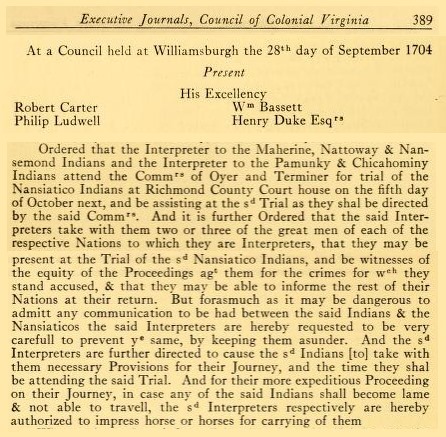
1705
The Act fixed the boundaries of the lands of the Nottoway and Maherrin Indians.
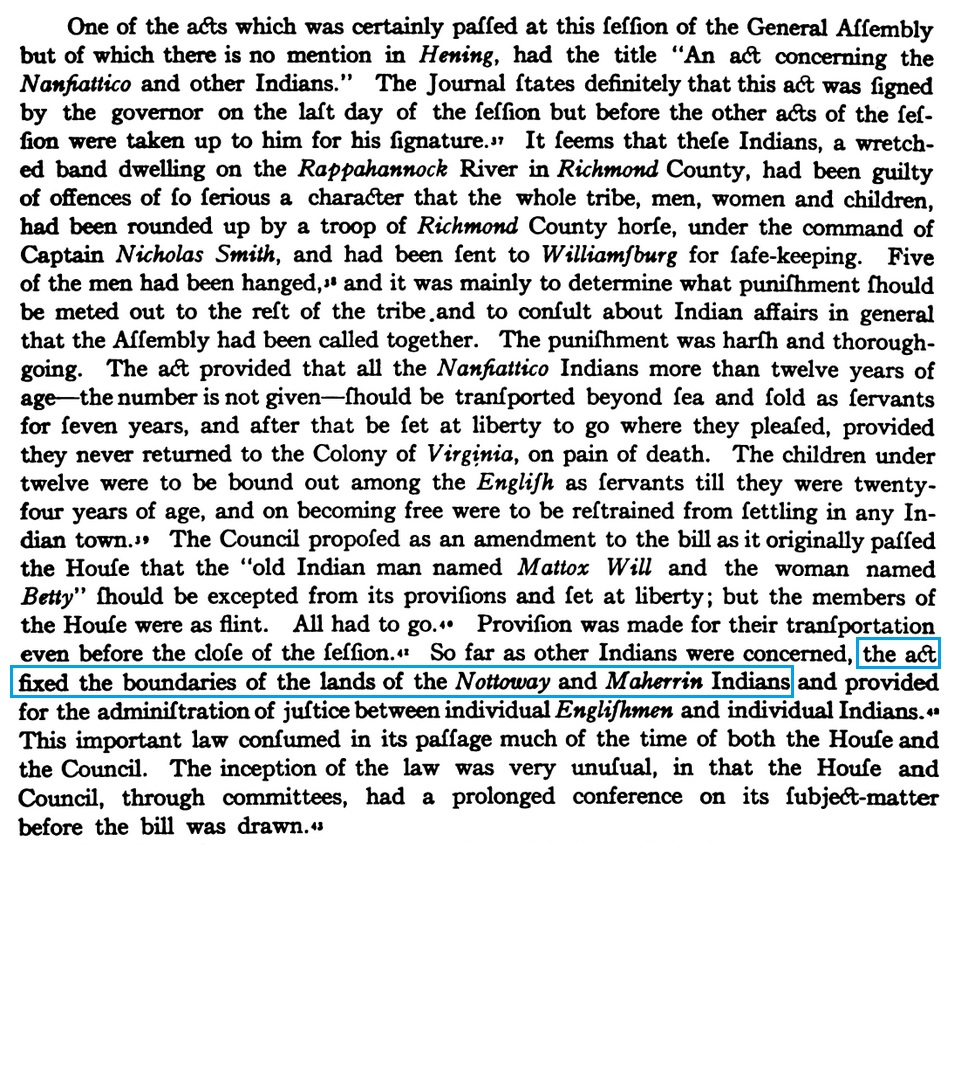
1705
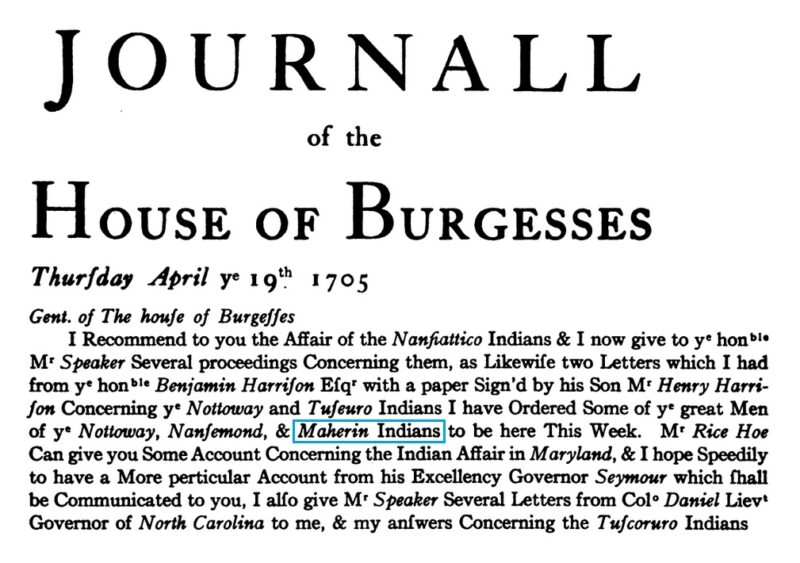
1705
Journal of the House of Burgesses at a General Assembly dated April 21st, 23rd, and 24th, 1705, Interpreter Henry Briggs having previously visited the Nottoway Fort, and being aware that he was currently in Williamsburg along with some Meherrin Indians requested that he appear before them to give an account of the number of Men, Women, and Children within the Nottoway Town. Henry Briggs is also asked to bring the Meherrin that are with him so that the House may ask them if they have any matters to address. The following day (April 24, 1705) Henry Briggs presents the House with a written Petition of The Maheron (Meherrin) Indians.
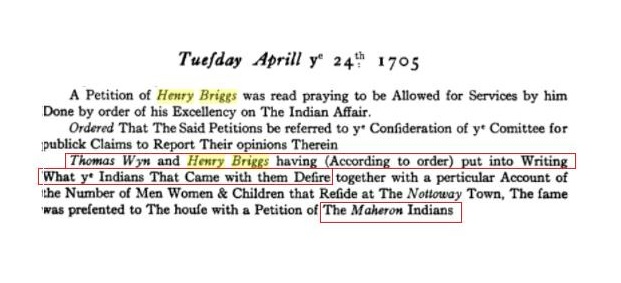
1705
Virginia established the second reservation in what is now North Carolina, for Meherrins who were living at Meherrin Neck (Maney’s Neck).
1705
1705
[Three-mile round reservation to be set out for Meherrin between the Meherrin and Nottoway Rivers.] “Resolved That The Bounds of The Maherin Indians Land be Laid out as Followed! (viz.) a Streight Lie Shall be Run up The Middle of The Neck between Maherin River and Nottoway River from The Mouths of the Said Rivers so far as will Include between that Line and Maherin River So much Land as will be Equal in Quantity to a Circle of Three Miles Round Their Town.
Resolved That Provision be made That when any Englishman Shall Do any Injury to an Indian upon Complaint made to the next Magistrate he shall Send a Warrant for the person Complained against and if he finds The matter within his Cognizance he shall do the Indian The Same Right that should be Done to an Englishman….”
Virginia Journals of House of Burgesses, 1702-1712: 98. April 28, 1705
1705
May 8, 1705
![]()
1705
Virginia established laws that deprived all nonwhite persons, including Indians, of legal rights including the right to testify in court. Meherrins were unable to use the courts to settle land disputes or collect debts against Colonists who were stealing our land and food.
1705
Sessional Papers [my transcription]
“Ordered that the Surveyor of Nansemond County do withall convenient speed lay out & survey the land oppoitioned for the use of the Mahorin Indians by an Act passed the last session of the Assembly Entitled an Act concerning the Nansiatico & other Indians according to the directions of the said Act.”
British Public Record Office, Colonial Office 412/27, Sessional Papers 1704>1705; Virginia Colonial Records Project: SR 1475 (1604)/11: Reel #87, p. 51vo. May 31,1705.
1705
“And for the better concealing of it, it is ordered that the Cleric of the Council do not issue the Order of Council 31st May to the Surveyor of Nansemond for laying out the Maherin Indians’ land till Mr. Minge be ready to go out with him to take the aforesaid observation, that the people of North Carolina may have no other suspicion than that those surveyors are only going about the laying the Maherin Indians’ land.”
British Public Record Office, Colonial Office 412/27, Sessional Papers 1704-1705; Virginia Colonial Records Project: SR 1475 (1604)/11: Reel #87, p. 51 vo. June 26,1705
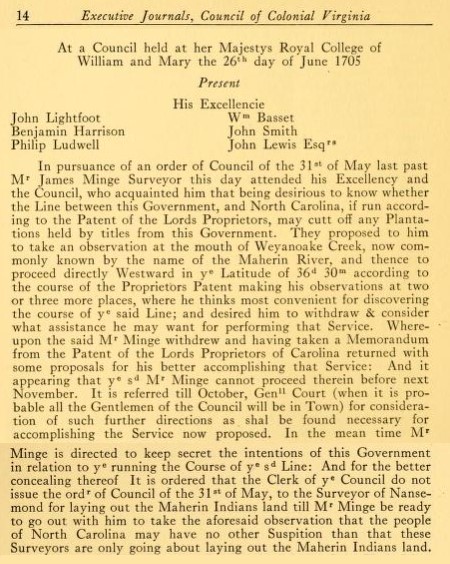
1705
In the Minutes of the Virginia Governor’s Council on June 26, 1705, the council proposed to determine that course of the state line but to “keep secret the intentions of this Government” under the guise of “laying out the Maherin Indians land” (DocSouth, Minutes of the Virginia Governor’s Council, June 26, 1705). In this camp three of the Meherrin Indians made us a visit. They told us that the small remains of their nation had deserted their ancient town, situated near the mouth of the Meherrin river, for fear of the Catawbas, who had killed fourteen of their people the year before; and the few that survived that calamity, had taken refuge amongst the English, on the east side of Chowan. Though, if the complaint of these Indians were true, they are hardly used by our Carolina friends. But they are the less to be pitied,
because they have ever been reputed the most false and treacherous to the English of all the Indians in the neighbourhood (Byrd 1866 [1728-1729]:67).
(WEAPEMEOC SHORES: THE LOSS OF TRADITIONAL MARITIME CULTURE AMONG THE WEAPEMEOC INDIANS by Whitney R. Petrey. page 130)
1705
1705
The second reservation in what is now North Carolina was established by the Virginia Colony for the Meherrins at Maherrinneck (later called Manleysneck). This region was claimed by both coloines at the time and was ultimately taken by Carolina. The reservation was reduced by Carolina in 1726. It was again reshaped in 1729.
1705
In 1705, Robert Beverly II (1968) reports that the Meherrin have only 30 bowmen “by Nansemond,” which probably accounts for only one of their settlements at the time – either the Tawarra or the Meherrin Neck Town (either could be interpreted as “by Nansemond” – one to the east, the other to the south).
(The Secret History of the Meherrin page 78)
1706
In 1706, the Virginia Executive Council proposed to the Queen that even if the Meherrin Town was discovered to lie within North Carolina that “the said Indians
still have their dependance on this government” (Mcllwaine, Vol. 111:112).
(The Secret History of the Meherrin page 78)
1706
“The Great men of the Maherine Indians making application to his Excellency that their possession of certain Small parcells of land Seated and planted by them without the bounds allowed them by act of Assembly may be continued to them, Ordered the Surveyor of Nansemond County make enquiry & Report to his Excellency what allowed them by law and in whose Entrys the Same be to ye end that where patent shall be granted for ye said lands the possession of the Said Indians may be Reserved to them for Such time as this Board shall think Reasonable & in the Mean time it is ordered that ye Said Indians have liberty to occupy & enjoy the Sevll plantations whereon they arc now Seated without any trouble or Molestation.”
Virginia Executive Journals of Council (Mcllwaine) III: 83. April 26,1706.
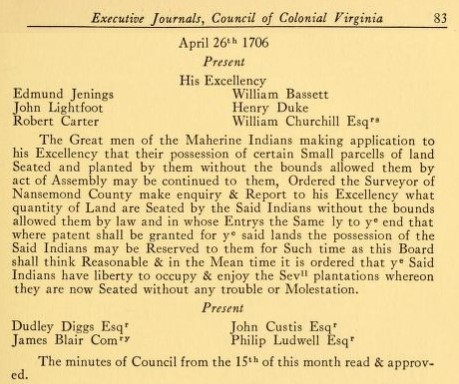
1706
June 17, 1706
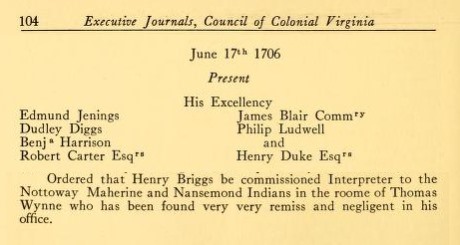
1706
Petition from Meherrin Indians asking to have until spring 1707 to effect their removal to north side of Meherrin River. Granted — to be moved by the end of March 1707.
North Carolina Colonial Records (Saunders), Series II, Vol V II: 7. November 1, 1706
1706
“Upon reading at this Board an address to his Excellency from the Burgesses relatcing to the bounds between this Colony and Carolina Ordered that a letter be prepared for his Excellencys Signing directed to Sir Nathaniel Johnson Governor of Carolina to desire him to give directions to his Deputy Governor that no encroachments be made on the Inhabitants of this Colony nor any disturbance offered to the Maherine Indians untill the bounds between both Governments be settled, and it is the opinion and advice of the Council that his Excellency represent to her Majesty the case of the said Indians they haveing been tributarys to this Government long before the Charter of the proprietors of Carolina, and pray her Majestie, that if the lands possesst by those Indians should fall within the bounds of their Charter her Majestie will be pleased to declare that the same and the said Indians still have their Dependance on this Government.”
Virginia Executive Journals of Council III: 112. June 22,1706
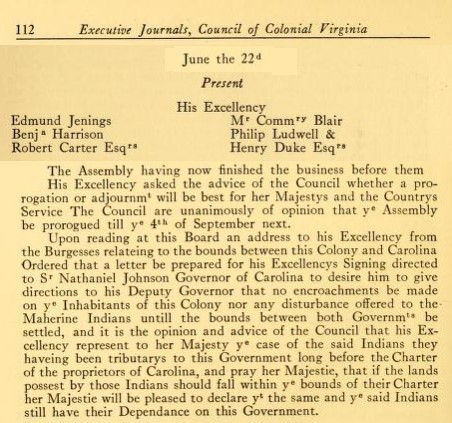
1706
Letter dated October 17, 1706 from Thomas Garrett to Thomas Pollock,
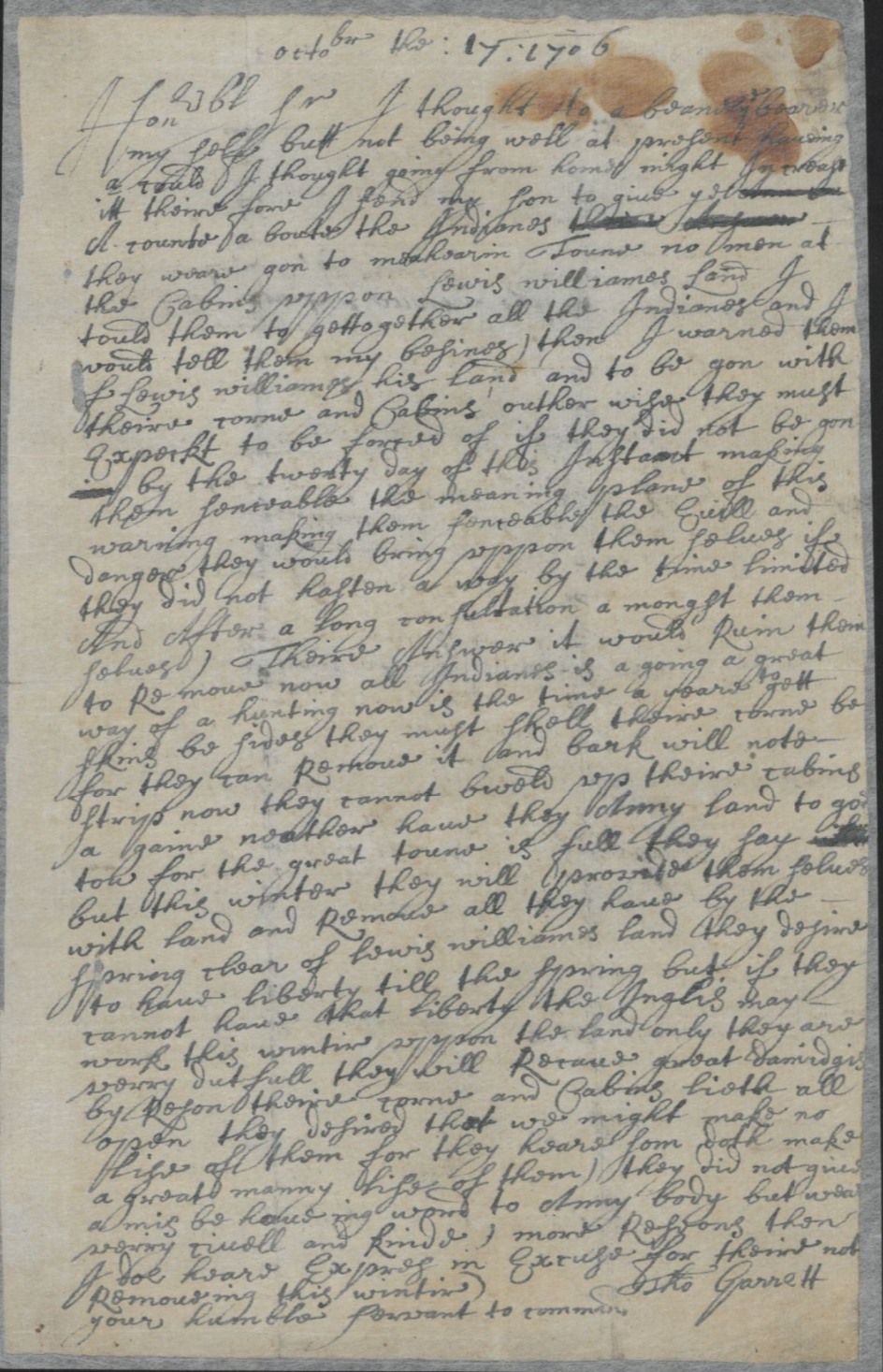
Honorable Sir
I thought to a bean my sclfc butt not being well at present haveing a could I thought going from home might Increase itt theirefoie I send my son to give you Accounte aboute the Indians they weare gon to menhearin Towne no men at the Cabins uppon Lewis Williams Land I tould them to gottogether all the Indians and I would tell them my besines, then I warned them of Lewis William es his land and to be gon with theire com e and Cabins* outher wise they must expeckt to be forced of if they did not be gone by the twenty day of this Instant making them senseable the meaning plane of this warning making them senseable the Evill and danger they would bring uppon them selves if they did not hasten a way by the time limited And After a long consultation amongst them – selves Theire Answer it would Ruin them to remove now all Indians – is a going a great way o f a hunting now is the time a yeare to gett skins be sides they must shell theire com e be for they can Remove it and bark will note strip now they cannot bueld up theire cabins againe neather have they Any land to go tow for the great towne is full they say but this winter they will provide themselves with land and remove all they have the spring clear of Lewis Williames land they desire to have that liberty till the spring but if they cannot have that liberty the Inglis may work this winter uppon the land only they are verry dutfull they will Receave great damidges by reson theire com e and Cabins lieth all open they desired that we might make no lise of them for they heard some doth make a great manny lise of them/ they did not give a misbehaveing word to Anybody but wear verry civell and kinde/ more Resons then I doe heare Exp res in Excuse for them not removeing this winter/ your humble servant to command
Tho. Garrett”
Manuscript, North Carolina State Archives. Colonial Court Records, Box o f Miscellaneous Papers, 1677-1775.
1706
Meherrin Town residents were ordered to “remove all their effects to the other side of the Moherrin River.” 1706 The Meherrin, who were already paying tribute to Virginia, were ordered to pay tribute to the Colony of Carolina. Carolina threatened the Meherrin with violence, warning of “the danger they would bring upon themselves if they did not hasten.” (McIlvenna, Noeleen. “A Very Mutinous People: the Struggle for North Carolina, 1660-1713” Chapel Hill, N.C.: University of North Carolina Press, 2009.)
The Meherrin asked for more time, as an immediate effort towards relocating their town would “ruin them” as it was the “time a year to get skins” and would have led to lack of trade commodities resulting in hardships and possibly starvation. Meherrins also claimed that they no longer had any land left to go to, as colonists took it all. The Meherrin people also stated concerns that they were being lied to again, as they were before. They were given permission to stay until the following spring.
(Dawdy, Shannon Lee. “The Meherrin’s Secret History of the Dividing Line” North Carolina Historical Review. 1995 72 (4): 385- 415)
1706
Commissioners had long been appointed by Virginia and North Carolina to serve as intermediaries between colonial governments and independent Indian nations, and continued to be employed long after the tribes were forced to accept tributary status. The presence of commissioners would have indicated a continuation of diplomatic practices for those tribes visited by them. In these cases, members of the village never appeared before formal governing bodies. In 1706, for example, Commissioner Thomas Garrett wrote to Council, relaying from the Meherrin Indians their “Excuse for their not removing [from Lewis William’s land] this winter,” as had been ordered by the Council that summer. The Meherrin themselves were not required to appear before the council in this instance.
(In the “Scolding Houses” Indians and the Law in Easter North Carolinia, 1684-1760. Michelle LeMaster. Page 209) The North Carolinia Historical Review Vol 83, No. 2 (April 2006), pp.193-232 (40 pages).
1707
The Meherrin were told to relocate their town immediately. However, the Meherrin asked for compensation for their fertile, cleared fields. They contacted Virginia for assistance in this matter against Carolina, and reminded Virginia that they were to be treated as a sovereign nation, and had always in-turn recognized Virginia’s sovereignty. This was during the border dispute between the colonies, which the Meherrin used to their advantage. (Dawdy, Shannon Lee. “The Meherrin’s Secret History of the Dividing Line” North Carolina Historical Review. 1995 72 (4): 385- 415)
Virginia stepped in, informing Carolina that the Meherrin were “entitled to her Majestys protection.” And that if any hardship were to come to the Meherrin, that Virginia “must be oblieged to take other measures to assert her Majestys right, and do justice to the Said Indians.”
1707
“Whereas it hath been represented to this Board by the Maherine Indians that sevll persons under pretence of grants from ye Govement of North Carolina have seated plantations within their bounds and have proceeded so far as to make Cornfields within their Towns and threatened to turn them out of their Settlement which they have enjoyed for many years. It is the opinion of the Council that the Maherine Indians having alwayes been tributary to this Government and enjoying the protection thereof together with their lands by Vertue of the Articles of peace concluded between the Govemmt & the said Indians ought still to be protected in the possession thereof from the pretensions of the Government of Carolina… ”
Virginia Executive Journals o f Council (Mcllwaine), Vol III: 143. April 16, 1707.
1707
April 22, 1707
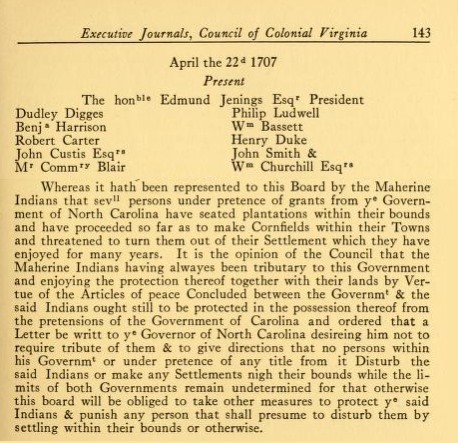
1707
THE MEHERRIN INDIANS.
North Carolina June ye I7th, 1707.
Honob” Gents: *
We received yors containing the complaint of the Meherring Indians pretending encroachments made on them by the inhabitants of this Government &c. Upon consideration of which we thought we should not better answer yo’s than by sending you the true state of that matter, being always as willing to give all reasonable satisfaction concerning our proceedings as * * * undoubted right of the Lords Propriet” and Her MajtyeY Subjects of this Governm’t. Of a long time before the memory of man, the Lands on the South side of that river which is now called Meherrin, was in ye right full possession of the Chowanohs Indians, by virtue of a grant from the Yampins Indians and no other Indians (as plainly appears by Successive Treaties of that niation by Originall Writings & undoubted Evidence,) has had any Right to any Land there to this day, & when first the Lords proprietors of Carolina, by virtue of their Charter from his late Sacred Majesty Charles 2nd took possession of this province that nationi submitted themselves to the crown of England and the Dominion of the Lord proprietors & continued till about the year I679, about which time by Incitement of the Revolutionary Indians of Virginia they committed hostility upon ye Inhabitants of this Gov’ ment in violation of their treaty, whereupon by vir- tue of authority by their charter, open Warr was made upon ye sd. Indians, in prosecution whereof by God’s Assistance, tho’ not without ye Loss of many men, they were wholly subdued & had land for their habitation assigned them where they remain to this day, so that all that tract of Land on the South side of ye Meherrin River was at that time assigned into the Immediate possession of the Lords propriet’ of Carolina, as of their province of Carolina & has been peaceably by them held without any claims now thirty years, During which time ye Meherrin Indians removing themselves from their ancient place of habitation (where by virtue of a Treaty which commissioners appointed by his late Majtle King Charles 2d they were settled,) placed themselves at the mouth of the Meherrin River on ye North side & a great part of the Tract of Land on the Souith Side & lying waste, some of their straglers planted Corne & built Cabbins on the Roanokes old fields & continued more & more to make their Incroach- ments till they became an Intollerable annioyance to her Majes- tyes subjects, committing repeated Injuryes upon their stock And making frequent affrays upon their persons as far as Moratuck River, for the nessessary redressing of which growing encroachments, and preventing more mischief which was dayly threatened, & reasonably feared the Government here, (& which was the best that they in discharge of their duty could doe) held a treaty with the chiefs of the said Indians, & instead of insisting upon Sattisfaction for the wrongs already Done, were content to make only necessary provision for the safety of her Maj’tY Subjects for the future, in order to which it was concluded that the stragling vagrant Indians of that Nation Should remove their Towne on the North Side of the River & that Towne they should peace- ably Enjoy for a Certaine Tribute, which was as we believe the first title that ever they had to it, for their treaty with the Com- missioners aforementioned gives them no more Right to the Land whereon they now Dwell than it would do to Land on the North side Patomock or the South side of Cape Feare, if they should remove themselves to any of those places. It seems to us yett more Advisable and wold lend more to her Maj’tye’s interest and present settlement as well of Virginia as of this province that they in force of their Afore’4 Treaty and for preserving their Right by their Majtyes protection, by virtue of it should be forced to returne to the place of their former Habitation than that they should be suffered to possess the mouth of a navigable River, considering how they have hitherto behaved themselves, which we recommend to yr consideration. Wee would not relate to you ye reasons for making the Meherrin River the Bounds, who are all very well acquainted with the Indians planting Corne without Fence, Soe that now English can Seat them without danger of trespassing by their Cattle and horses, and which the Indians, and Especially that Nation, are very ready to roving without measure, So that the question is not between the right of Louis Williams [the man claiming the ground] & the Meherrin Nation, But whether near a hundred Families of her Maji”e Subjects of Carolina should be despoiled of their free-holds to lett a few vagrant and Insolent Indians rove where they please without any right & contrary to their agreenient. We have always thought it necessary that the Indians should live togather in Townes, where all their young men may be under the imediate inspection of their own Government to prevent their private mischief that may be done more safely & concealed in single & seperate familys. Yor proposition concerning further settlement was in all Friend- ship received, but because of the uncertainty we could not pro- ceed to make any order or provision in Answer to it till by the copies of the Depository to be taken on yr behalf, which we hoped to receive, we might have obtained Information how far the controverted Grounds were Extended to usward, we knowing no bounds to Carolina but Wyanoke River till further informed, designing no farther to Enter into that controversie but only to represent the Case to the Lords proprietra in order to their laing it before her Sacred Majtle, Seeing no cause to doubt of the Suc- cess in soe clear a case. To this we add that Louis Williams can’t be called any new settlement, for he had Right to that Land some years agoe, and he has been hindered settling by those Indians who have dallyed with this Government from time to time by promises to depart & now at last being called to show reason of their delay, they only could alledge that they had cleared some ground for which Labour they desired Satisfaction, & Williams being willing to be in practable possession of his land at any time, agreed to pay them a Horse & fifteen Bushells of Corne * * * * all they at that time desired & the great- est part they have received and the remainder has been tendered, but upon their returne from Virginia they have refused to receive the remaining part & made a barbarous assault upon him in his own house, soe that his life is doubted off & his Familye in danger of further trouble from which we believe it our Duty to rescue him, for we can’t Interprett yr proposition to mean that in the meantime any of her Majtes Subjects ought to be left to the mer- ciless Insults of Such Savage people, but that Every one in their respective government as they are now deemed should quietly enjoy their properties till the matter be determined, to wc’ we readily assent and assoom, as we know how farr you do claime, shall take all necessary order in it. We have sent you the copi’ of such deppositions as we have taken relating to the Bounds, and desire you will send us those that have been taken by you according to yr promise.
We are Your Humble Servants,
W. GLOVER,
SAM’L SWANN,
EDWARD MOSELEY, F
RAN. FOSTER.
(The Meherrin Indians Source: The Virginia Magazine of History and Biography, Vol. 5, No. 3 (Jan., 1898), pp.268-271 Published by: Virginia Historical Society)
1707
Meherrin Town was attacked and destroyed: Thomas Pollock and a troop of 60 men, attacked Meherrin Town, captured 36 men, and held them there for 2 hot August days. The Meherrin claimed that they were almost killed as they were deprived of water. He and his men destroyed the Meherrin’s homes, crops, and all belongings.
In September, the Virginia militia met with the “Great Men” (Chiefs) of the Meherrin and pleaded with them not to retaliate against Carolina, promising that Virginia will “protect them.”
The Virginia Council President, Col Edmond Jenings later sent a chastising letter to Carolina’s leading official, listing each infringement made upon Meherrin sovereignty, and two depositions from Meherrins- “our ancient inhabitants” who were there well before “Carolina had being.” He scoffed at Carolina for seeking illegal title to Meherrin lands, and told Carolina that they “have been the Agressors.” The Meherrin were “not to be considered as a nation of Savages” Jennings warned Carolina that the Meherrin might bring in their Native allies to “Revenge their wrongs.”
(McIlvenna, Noeleen. “A Very Mutinous People: the Struggle for North Carolina, 1660-1713” Chapel Hill, N.C.: University of North Carolina Press, 2009.)
1707
“Whereas this Board have received Information that one Collo. Pollock of the province of No. Carolina with severall armed men Inhabitants of that province did lately and in hostile manner sett upon the Maherine Indians Settlement and having taken 36 of the said Indians prisoners kept them two dayes in a Forte till with the excessive heat and for want of water they were almost Destroyed after having broke down their Cabins and Committed severall other outrages threatening to Cutt up their Come and to turn them off their land. This board takeing into Consideration the ill Consequence of such unwarrantable procedings not only as they respect the frighting of the said Indians from their obedience to this her Majestys Government of Virginia but irritateing the said Indians to revenge themselves as well upon her Majesties Subjects of this Government as upon those of Carolina, It is therefore ordered that a letter be writt to the Deputy Governor or President and Council of No. Carolina ascerting her Majesties right to the land on which the Maherine Indians now live and to appoint the said Deputy Governor or president and Council that the said Indians have their Dependance upon and are under the protection of this Government assured to the Treatise of peace made by them and to desire the said President and Council not to molest the said Indians untill the matter o f right Concerning the lands whereon they live be Determined.
Ordered that Collo. Harrison send to the great men of the Maherine Indians and Caution them not to leave their Town upon any threatenings that may be made them by the Inhabitants of Carolina and to assure them that if any Disturbance be offered them by any person within that province the Council will take care to protect them
Virginia Executive Journals III: 152-153. September 2 ,1707
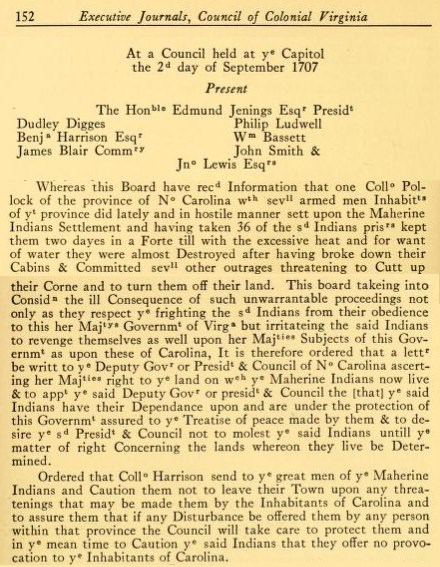
1707
Capt and Jurat Vicessimo primo die Januar anno 1707 Coram me 44 Edwd Moseley
North Carolina ss.
Before me Edward Moseley Esqr one of the members of the Council and being Authorized to take the Depositions of Certain persons relateing to the boundarys of this Government, personally Came and appeared Richd Booth aged sixty three years or thereabouts who on his Oath on the Holy Evangelists taken saith that in or about the year 1661 this Deponent came into Virginia and served Major Merritt six years (who then lived about Twenty miles from the Weyanoake Indian Town the Weyanoks living very near a plantation that now belongs to Collo Harrison betwixt Blackwater River & Weyanoake River which Weyanoake River by reason of the Declension of the Weyanoake Indians and the Nottoway Indians removing nigher to it has since in this Deponents memory gained the name of Nottoway River by the Virginians) And this Deponent further saith that in the year 1667 he being employed by one William West to go in a Canoe with Certain goods &c to the Maherine Indian Towns one Jno Browne and a certain Weyanoake Indian called Tom Frusman being in the Canoe with him as they went down Blackwater River this Deponent then being a Stranger in those parts any other than by hearesay enquired what river that was they first mett with on their Right Hand they answered it was Weyanoake and Opposite to the Rivers mouth was a field belonging to the Weyanoakes it being then about one of the Clock in the afternoon this Deponent enquired how far it was to Maherine River they answered they should gett there before sun down which they did accordingly whereby this Deponent Computed it was about thirteen miles by Water and this Deponent further saith that he never understood that the Weyanoake Indians ever lived to the Southward of that River
RICHd BOOTH.
(Colonial Native Dispossession of North Carolina Researched by: Baylus C. Brooks Research Assistant: Julie S. Brooks. Pages 43-44)
1707
Oct 21st, 1707
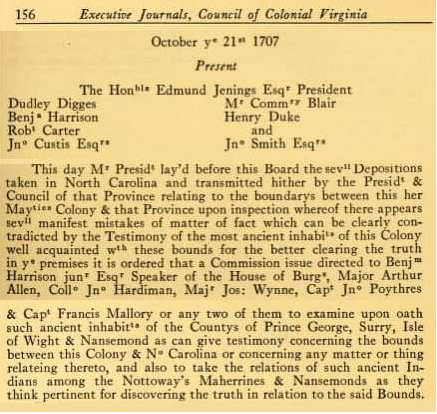
1707
Oct 29th, 1707.
Meherrin interpreters and two great men from the Meherrin Nation are ordered to be present at the trial of Tuscarora Indians accused of murdering Jeremiah Pate at the head of the Pamunky River.
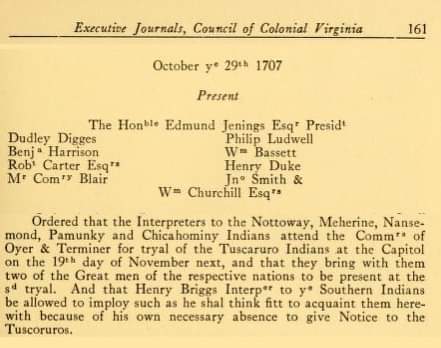
1707
Letter from E. Jenings, VA Governors Council, to NC Commissioners “. ..
As to the Right which you say was derived from the Yawp in e Indians by Grant to the Chowanoakes and from them acquired by the Lords Proprietors by Conquest We can’t apprehend it so easie a matter to ascertain what Rights an Indian Nation had to such a particular Tract of Land before the memory of man their Title begin as precarious as their means of Transmitting the same to posterity are Defective but supposeing the whole to be True which we must take Leave to doubt of till we are better satisfyed of the Validity of those imaginary Indian rritings and Records… We admire to hear it offered that a Clandestine Treaty between the Government o f Carolina and the Maherine Indians should Create a Title to their Lands or be a pretence of exacting Tribute from them who were long before Tributary to her Majesty Dominion o f Virginia by Virtue of a treaty which has the Royall Approbation And it is Strange that the Government of Carolina should go about to prescribe bounds to those Indians in Lands which their Charter gives them no Right to at least which hath been alwayes Claimed by the Government of Virginia… On the Contrary it will be found that the Government of Carolina have been the Agressors and by granting Lands to any one that would purchase it without considering whether they had Right or not so to do have endeavoured so to streighton the said Indians that they might be no longer able to subsist where they live in hopes afterwards to possess themselves of their Lands by the same Title they hold the other Lands thereabouts…” 157 … We shall not think fitt to alter their present Settlement especially since we know the Indians have possest their Lands long before Lewis Williams had any pretence of Right to his
and we cannot perceive how the Supporting the possession of those Indians can be called a disseising her Majestys subjects of Carolina of their freehold if their settling there be (as we doubt not it will appear) without any Title… … one Collo. Pollock of Carolina with about sixty armed men in an hostile manner sett upon the Maherine Indian towne makeing all the Indians that were therein prisoners and so keeping them pent up for two days in a small fort till with the straitness of the place the excessive heat of the weather and their want of W ater they were almost famished, threatening further to bum their Cabbins and broke and destroyed such poor furniture as the Indians had therein, and to make that Action the more unaccountable (to give it no more name) the said Pollock had the assurance to affirm he had the Queens order for what he did. Gentlemen your own letter plainly intimates that you are not unsensible of the Maherine Indians being under his Majesty Subjection as o f h o 1 Dominion of Virginia by Virtue of a Treaty Concluded with them and that they are thereby entitled to her Majestys protection It is then as plain that those Indians are not to be considered as a Nation of Savages on whom the Govemement of Carolina have power to Revenge injurys by force of Armes but as her Majestys Subjects who are as much under her protection as any of her Subjects o f Virginia… W e might with as much justice treat those who possess the adjoining Lands (and pretend to belong to Carolina) with the same severity as you have used those poor Indians since we have at least as much Reason to believe them within the bounds o f Virginia as you have to imagine the Maherine Indians to be within yours… And if this late attempt be not the ready way to irritate those Indians to shake off their obedience to her Majesty and by bringing forreigne Indians to Revenge their Wrongs involve both us and yourselves in war and all this for o other Account but to satisfy the selfish interest o f Collo. Pollock and some few insatiable people who aim at the Indians land We think ourselves obliged in her Majestys name and on Behalf of this her Majestys Colony to demand Reparation for so unwarrantable an attempt and that you’l punish Collo. Pollock and those concerned with him as such an insolence Deserves But if no such satisfaction be given us we
shall then conclude he acted by your authority…”
North Carolina Colonial Records (Saunders) I: 668-671. September 15,1707
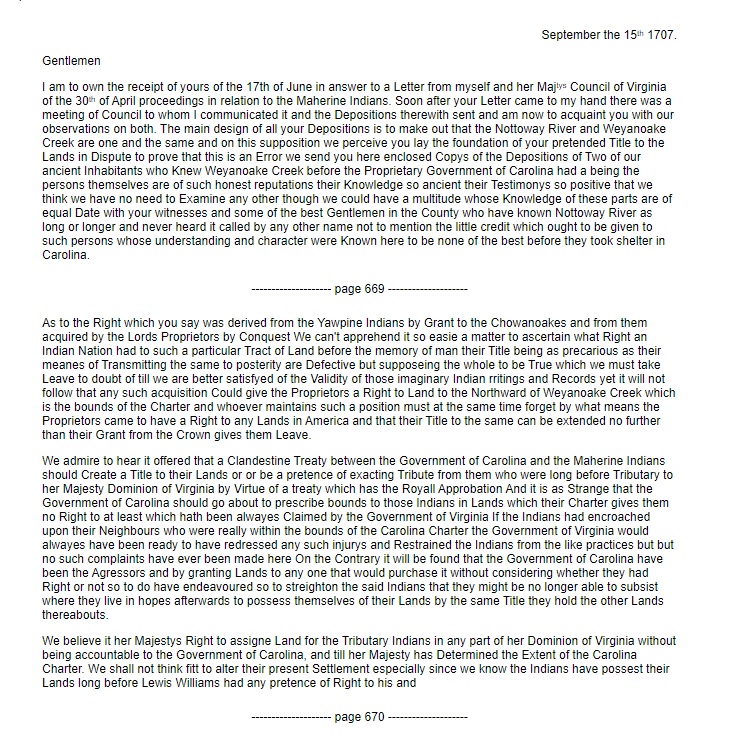
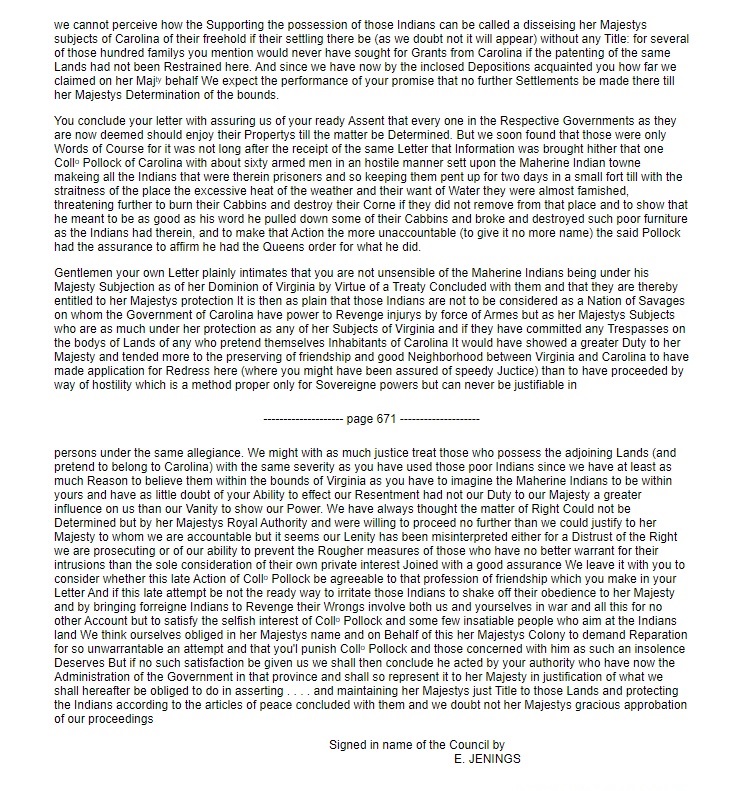
1707
Deposition of James Thweat
“That about fourty-eight years ago [ca. 1659] the Meherin Indians lived upon Meherin River at Cowochahawkon, and some o f them at Unote, and about four and twenty years ago they Lived Some o f them at Unote and some at Taurara [ca. 1683], but how long they lived there after that time, he cannot particularly remember.”
Virginia M agazine of H istory and Biography (Stanard, ed.) VTI(4), 1900: 343. November 12,1707
1708
Oct 26, 1708.
Royal Proclamation prohibiting trade with the Meherrin, Tuscarora and Nottoway.
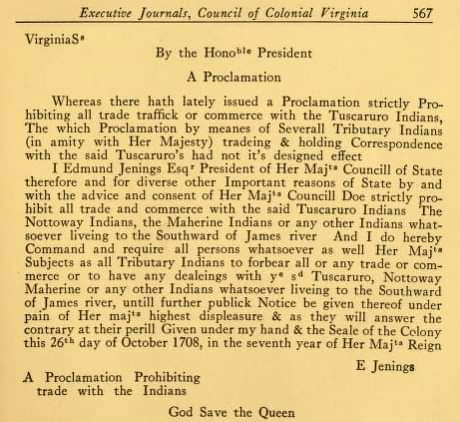
1708
Occasioned by the clandestine practice of diverse persons who under pretence of tradeing with the Nottoway and Maherine Tributary Indians… have by their means entertained a Commerce with the said Tuscaruros
(Mcllwaine, Vol. 111:200,October 26, 1708).
(The Secret History of the Meherrin page 83)
1708
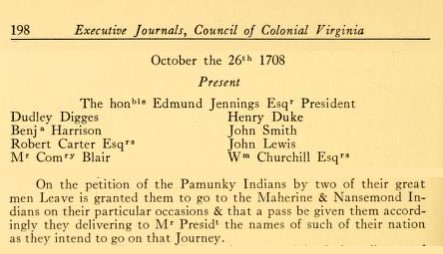
1708
“On the petition of the Pamunkey Indians by two of their great men Leave is granted them to go to the Maherine and 158 Nansemond Indians on their particular occasions and that a pass be
given them accordingly they delivering to Mr. President the names of such of their nation as they intend to go on that Journey…. Whereas the late proclamation for prohibiting Trade with the Tuscaruro Indians hath not had the desired effect, occasioned by the clandestine practice of diverse persons who under pretence of tradeing with the Nottoway and Maherine Tributary Indians and with other Nations in amity have by their means entertained a Commerce with the said Tuscaruros… It is ordered that a proclamation issue prohibiting all manner of persons to trade with the Tuscaruro Indians or any other Indians liveing to the Southward of James River and ordered that Mr. Attorney Generali prepare the said proclamation.”
Virginia Executive Journals of Council (Mcllwaine) III: 198, 200. October 26, 1708.
1709
Lawson’s New Map of the Carolinas – 1709
Fac-Simile of a Map of the Inhabited Parts of N. Carolina
Prepared by Ion Lawson, Surveyor General of N.C. 1709
Drawn by Geo. Schroeter, N.Y.
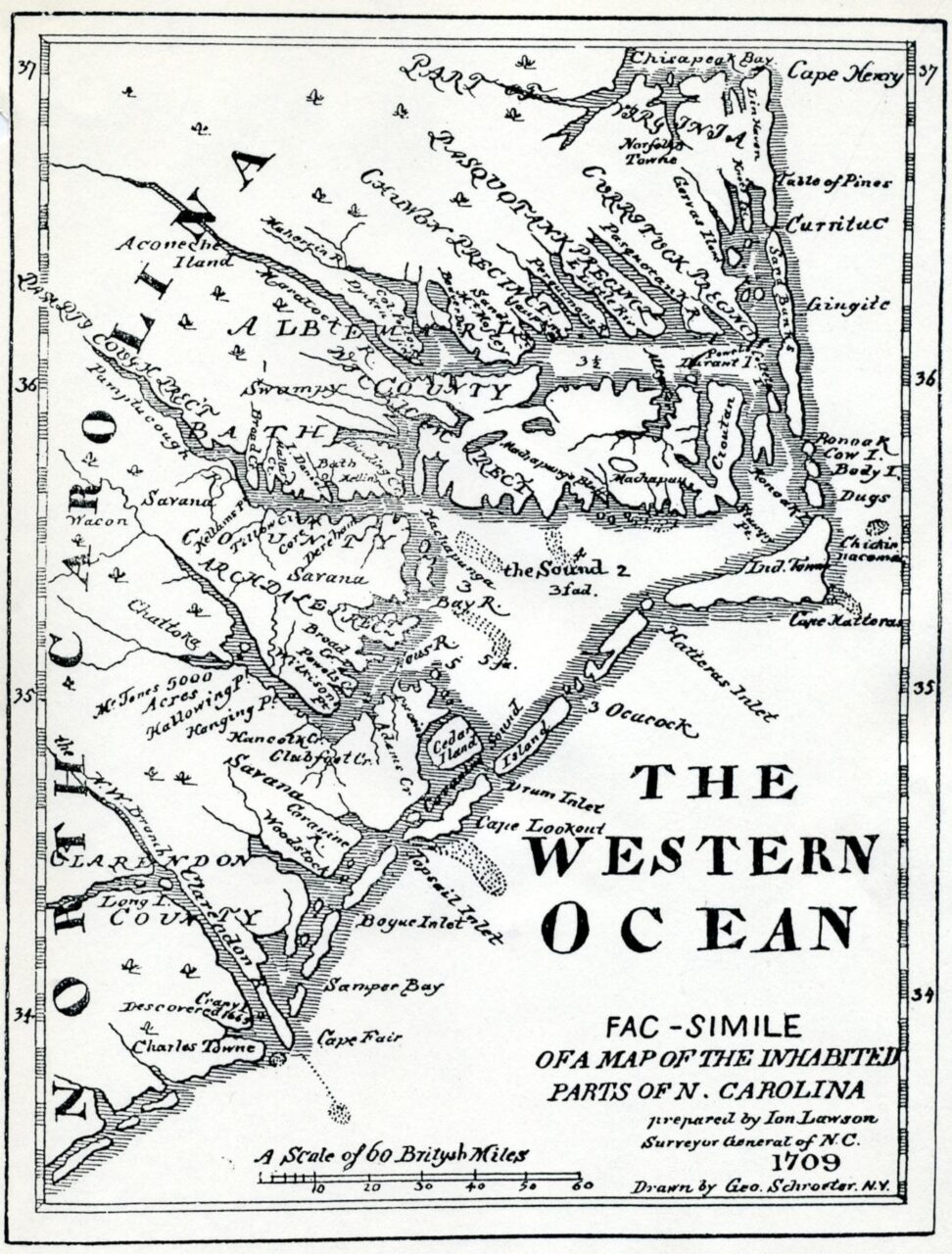
1709
The Chowanokes struggled along as an automous body politic for wel over a hundred years after the war. Subsequent epidemics wreaked still more havoc in the 1690’s, to the point that in 1709, John Lawson described the Chowanoke population as fifteen fighting men, and the Meherrin at fifty. For the Meherrins, this curiously differed not at all from the previous 1669 Virginia census. The Chowanokes, however, were drastically reduced to a remnant. This suggests a total population of perhaps sixty individuals, at great odds with the previous calculation of five hundred just thirty-three years earlier. Did they all succumb to disease, or was there a mass killing at the time of the Chowan River War? Another possibility, considering that the Meherrin population remained constant, is that following the war, many Chowanokes joined the Meherrins, rather than be confined to a reservation. This may have been the beginning of a merger that would become apparent in later years.
(“Sundry Murders and Depredation”.
A Closer Look at the Chowan River War, 1676-1677. Lars C Adams. Pages 169-170
The North Carolina Historical Review Vol 90, No 2 – April 2013)
1709
In 1709, Lawson reported a number – 50 bowmen – although
he noted only one Meherrin town (Lawson 1967:242).
(The Secret History of the Meherrin page 78)
1709
William Byrd, in his secret diary entry for February 23, 1709, notes that two
Nansemond and two Meherrin were used as messengers to the English by the Tuscarora (Byrd 1941:7)
(The Secret History of the Meherrin page 83)
1710’s
In the 1710s, despite population loss and migration, the Meherrin retained most of their traditional lifeways. They were still involved in trade (through the Virginia skin traders), practiced com agriculture supplemented by seasonal hunting and gathering, lived in bark cabins, and made decisions by council government. Lawson’s account suggests they
continued to make marriage alliances and base social status on achievements in war and hunting. Due to the boundary dispute, the Meherrin were treated by Virginia and North Carolina as a “nation.” The Meherrin dealt with Virginia’s government as they would their other large allies, and reacted to North Carolina as they would to traditional enemies. The friction between the two colonies supported these traditional foreigner roles.
(The Secret History of the Meherrin pages 89-90)
1710
One of Virginia’s Colonial Governors, Colonel Alexander Spotswood, founded Fort Christanna just four years after arriving in virginia in June 1710. He found the colony anticipating and Indian was. Though forbidden by the Queen and restricted by a peace treaty, some inhabitants of North Carolina were causing trouble bey settling in an area within three miles of the Meherrin Indian Town. The Meherrins were harassing the setllers in return.
1710

1710
Paraphrase and transcription of the 1710 Tuscarora speeches and belts to the lower Susquehanna towns (5 Nations, Shawnee / Miami), likely representative of the collective Chowan, Meherrin, Nansemond, Nottoway & Tuscarora perspectives of the period:
The first belt was sent by “their old Woman, that those Implored their friendship of the Christians & Indians” of Pennsylvania, “that without danger or trouble they might fetch wood & Water.”
The second belt was “sent from their children born, & those yet in the womb, Requesting that Room to sport & Play without danger of Slavery, might be allowed them.”
The third belt was sent from their “young men fitt to Hunt, that privilege to leave their Towns, & seek Provision for their aged, might be granted to them without fear of Death or Slavery.”
The fourth belt was sent from “the men of age, Requesting that the Wood, by a happy peace, might be as safe for them as their forts.”
The fifth belt was sent from the whole nation, “requesting peace, that thereby they might have Liberty to visit their Neighbors.”
The sixth was sent from their “Kings & Chiefs, Desiring a lasting peace with the Christians and Indians of this Govmt., that thereby they might be secured against those fearful apprehensions they have these several years felt.”
The eighth belt was sent to “Declare, that as being hitherto Strangers to this Place [Pennsylvania], they now Came as People blind, no path nor Communicacon being betwixt us & them; but now they hope we will take them by the hand & lead them, & then they will lift up their heads in the woods without danger or fear.”
“These Belts (they say) are only sent as an Introduction, & in order to break off hostilities till next Spring, for then their Kings will Come & sue for the peace they so much Desire.”
The Tuscarora language was framed in the Iroquoian diplomatic style but contains the real sentiments of the Southside Indians. By solidifying a relationship with Pennsylvania, some Southern Indians might be afforded safe harbor, such as had been the case with the diasporic Susquehannock returning from Virginia – and possibly contained the sentiment of those descendants adopted by the Meherrin.
That warfare and slaving were mentioned in the majority of the belts’ symbolism, underscores the importance of this aspect of the tributaries’ overtures to the Northern Indians. With the Seneca overlords of the Conestoga at their side, the Shawnee presence confirms the emissary was to the lower Susquehanna towns. As potential allies of their linguistic cousins, the tributaries could afford to be bold in their dealings with their colonial neighbors but also would shore up the alliance against the Indians to their southwest and west – the groups emerging as the “Catawba.” Following the Conestoga council, the Seneca inserted their interests into the affair, taking the belts from the Pennsylvanians and sending them to the Five Nations for consideration. For their part, the Pennsylvania officials accepted the “sincerity” of the Tuscarora “Intentions” and could see no other reason to doubt them. They also recognized that the Tuscarora were “of the same race & Language with our Seneques, who have proved trusty, & have also for many years been neighbors to a Govnt. [Virginia and Carolina] Jealous of Indians, And yet not Displeased with them.” With these belts delivered and this conference held, the nearly ten years of diplomatic overtures to the Northern Indians was finally successful, at least more so than it ever was before.
Hazard II:511–512
1710
September 23, 1710
Historian Samuel Ashe suggested that these expeditions were against the Carolina Algonquins, the defeat of whom allowed for future settlement. This view, sometimes still cited, is taken without the context of the third Anglo-Powhatan War. When put in the proper context, the true target of the Weyanokes is much more obvious, as Helen Rountree noted. Looking at Henry Plumpton’s narrative, he specifically names their target in the place of their battle as Weyanoke Creek (known today as the Wiccacon), stating that they went “as far as the mouth of the Weyanook Creek where they had a fight with the Indians and had a man killed by them”. Rivers of this time are well known to be named after whichever Indian group lived there. This is approximately the site of the Choanoacs’ previous principal town, so the Weyanokes were in all likelihood occupying the Choanoacs’ former town site. This is also confirmed by the testimony of some Meherrin Indians interviewed during the late border dispute, when they drew a detailed diagram of the Weyanoke town and cornfields at Wiccacon in the dirt.
The 23rd. We took the Examinac̅ons of Great Peter the Nansemond Indian after his Examination he told us, that sometime before, he was sent for to Coll: Pollocks, where were Governor Hyde, Mr. Lawson, Coll: Pollock & others, they examined him concerning the Wyanoke Indians and Wyanoke Creek that he gave them the same relation he has given us, and that thereupon Coll. Pollock was angry with him & said, such stories would do the Proprietors a mischief; he answered that he did not come of himself to tell any storys, but was sent for, & if he desired to hear it, he would tell him the truth, but if that would not please him he would not tell him a lye. That Mr. Hyde said he was in the right, he said Coll. Pollock urged him very much to drink, but he thought that they had a design upon him & would not.
Then we proceeded to the Maherine Indian Town and took their Examinac̅on. at this place there was one John Beverley, who reckons himself an inhabitant of Carolina, whom we desired to take notice of the manner of our proceeding in taking the Examinations and of the questions asked them. This man had been all up Wicocon Creek & had taken up some land in the Fork of the Creek where the ground, the Creek & Swamps, & the places where the Weyanoke Indians had Corn fields he confessed the Creek Swamps & old fields were as described them.
Phillip Ludwell and Nathaniel Harrison, “Journal of the proceedings of Phillip Ludwell and Nathaniel Harrison [1710]” In Saunders,, Colonial Records, 1:740.
1710
Journal by Phillip LudweU <£ Nathaniel Harrison re: dividing line
“… But the Nottoway old men being gone to gather Chinkopens We deferred the taking their Examinacons till our Return, and went to the Nansemond or Potchiak Indians Town. In our way thither we mett one Richard Bratwell who told us that he had entered for about 1000 acres of land with Mr. Moseley and had it surveyed upon Maherine River, being persuaded to it by the sd Moseley, who assured him it was in the Carolina Government… The 23rd. We took the Examincons of Great Peter the Nansemond Indian after his Examination he told us, that sometime before, he was sent for to Coll: Pollocks, where were Governor Hyde, Mr. Lawson, Coll: Pollock & others, they examined him concerning the Wyanoake Indians and Weyanoke Creek that he gave them the same relation he has given us, and that thereupon Coll. Pollock was angry with him & said, such storys would do the Propreitors a mischeif; he answered that he did not come of himself to tell any storys, but was sent for, & if he desired to hear it, he would tell him the truth, but if that would not please him he would not tell him a lye. That M r Hyde said he was in the right, he said Coll. Pollock urged him very much to drink, but he thought they had a design upon him & would not. Then we proceeded to the Maherine Indian Town and took their Examinacon. At this place there was one John Beverley, who reckons himself an inhabitant of Carolina… The 2nd. The Maherine Indians not being at home, we proceeded to the Nansemond Indian Town.”
North Carolina Colonial Records (Saunders) I: 740-743. October 1710
1710
In Meherrin were listed as having 50 Warriors in 1710.
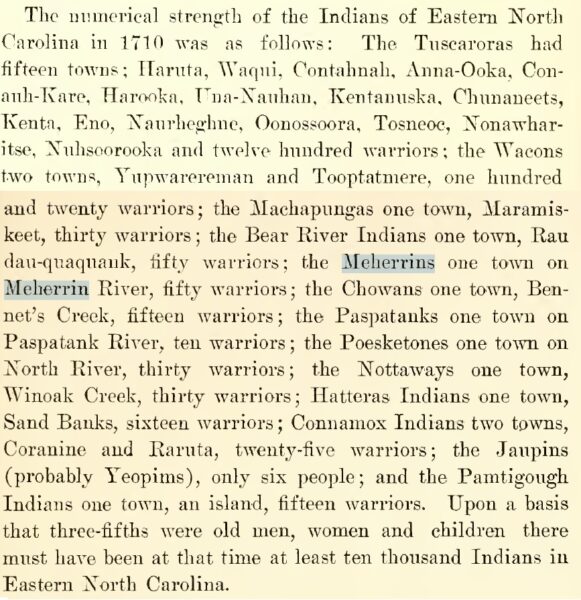
1710
The Examination of Nick Major, and Severall of the old men of the Maherin Indians 69 and upwards, say:
“That the Wyanoke Indians removed from J. River for fear of the Resentment of the Engl, after the Massacre and went to Roanoke River to a place called Towawink upon Roanoke R. where they planted Come (they think) 2 years and from thence they Removed to Wycocone Creek in a fork surrounded with Swamps and myery Pocoson and Lived there about 6 years and Planted Come in Severall places on both Sides of the creek and that he has heard theyr old men say that 2 Tuscarorra Kings one called Nico tan watts and the other called Corronwhankcokektold them that they had sold the Wyanoke Indians all the lands to the Southward of Cotchawhesco creek and upon Wycocons Creek and on the N. side of Roanoke R. from the heads of those Creeks Downward and that they have heard both from theyr ancestors and the Tuscaroras that these lands did really belong to these Kings; they alsoe say that they have heard from theyr ancestors that they went from thence to Wreckeck upon Nottoway R. and they never heard either from theyr ancestors or since they can remember any other name for it then Nottoway from the mouth upwards, and theyr nation called the Creek Wycocoms Quaraurawkebut the Indian fields upon the Creek they called the Wyanoke fields, and they never heard of any other place called Wyanoke Except at James River and that at Roanoke, and that they never knew nor heard that the Wyanoke Indians ever Lived at the mouth of Nottoway River or opposite to it on the other side black 159 water nor any other Indians Except the Chowans, nor ever heard of any Wyawnoke neck therabouts, and they say that they have heard there were such Indians as the Yawp in es but the lived soe farr off that thy never saw any of them nor ever heard that they ever claimed the Lands betwixt Roanoke and Maherrin River. They also say that Maherin River always went by that name.”
May 22, 1711 Nick Major and other old man of the Maheerink Indians, aged as we supose about sixty years, being examined and strictly forbidden to tell any untruth in hoes to please or fear o f displeasing anybody, and charged to tell the whole truth, say: “… they have heard theyr old men say that two Tuscarora Kings, one name Nicotaw W arr and the other named Corrowhaughcoheh, and one Tascaroora Queen called Ervetsahekeh (which two kings and queen Nich Major knew very well), told them that they had sold the Wyanoke Indians all the land to the Southward of Cotchawesco Creek and upon Wycocons Creek and on the North side of Roanoke River from the heads o f those creeks downward to Chowan… This examination taken in presence of Mr. Edward Moseley and Mr. John Lawson, Commissioners appoynted for the settlement of the Boundaryes between Virginia and Carolina.”
Virginia M agazine of History and Biography (Stanard, ed.) V III (1901176): 4-11. October 7, 1710 – May 22, 1711
1710
“The Petitions of the Nansemond and Maherine Indians praying their lands be laid out for them according to the Articles of Peace are referred until the bounds between this Colony and Carolina be settled.”
Virginia Executive Journals of Council (Mcllwaine), Vol. Ill: 260. October 27, 1710.
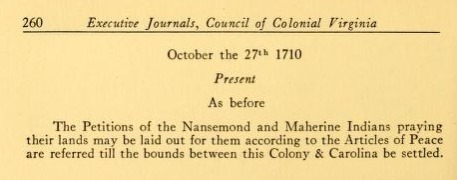
1710
1710-1720 Map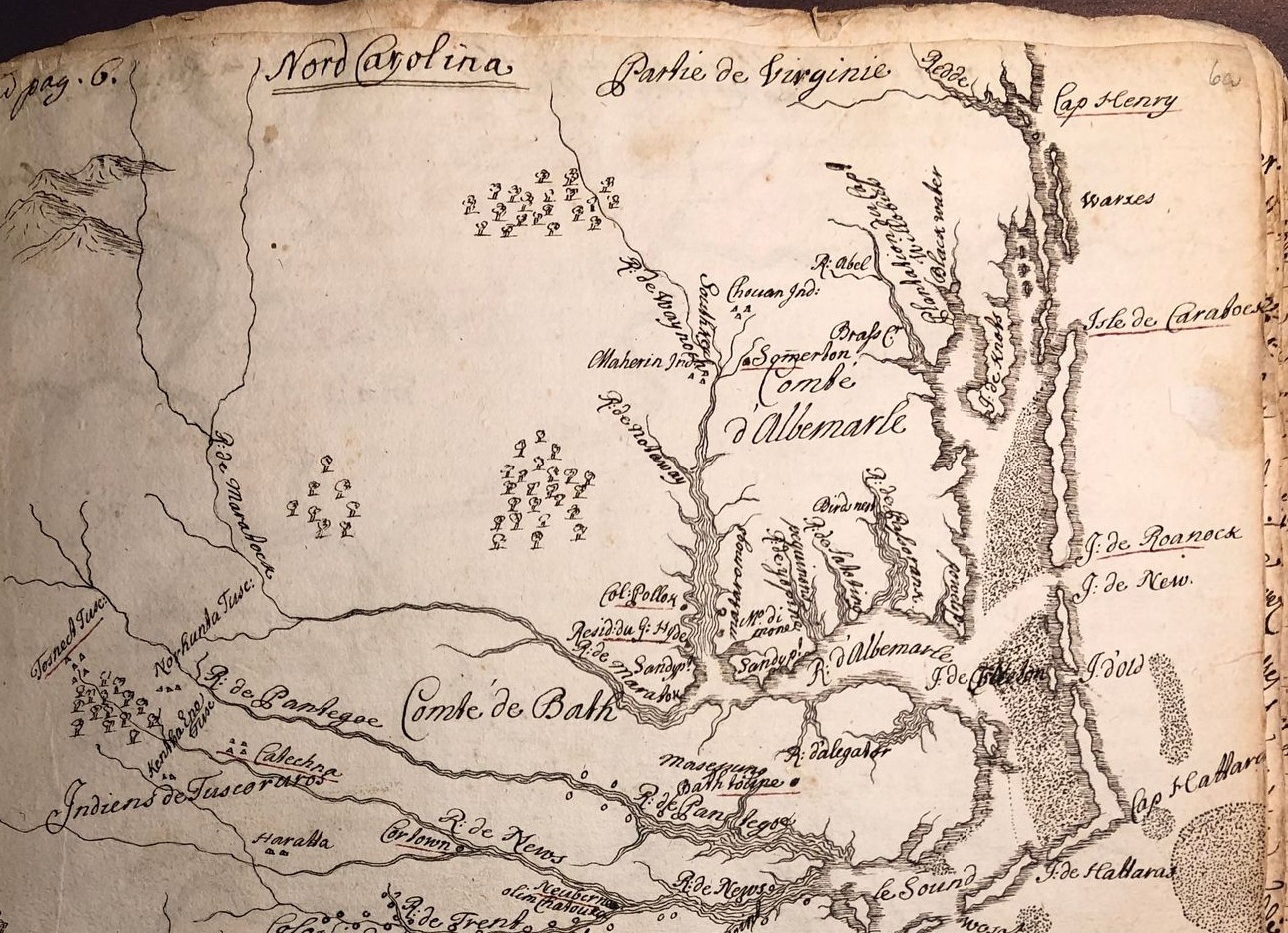
1710/1711
…than prudence. The power to execute them was not equal to the zeal which enacted them. Carey had still many adherents, and had no idea of submitting to arrest. His only resource, therefore, was to raise the standard of undisguised rebellion. This he did; and further, again declared himself president amidst the acclama-tions of a misguided multitude. And it so happened that in De-cember, 1710, just before these transactions, the Meherrin Indians, provoked by the ill-treatment of some profligate whites who lived near them, had taken redress into their own hands, and falling on the most distant settlement on the Chowan, had there killed some of the whites. The danger of an Indian war, therefore, should have taught the Assembly the gross imprudence of furnishing a pretext for contemporaneous civil strife.
We have no doubt from subsequent facts, which will be related in their order, that Carey saw the advantages he might derive from Indian hostilities, and resolved to avail himself of them when necessary. He had further satisfaction, also, of seeing the As-sembly so much engrossed by their legislation to punish him, that they actually adjourned without making the least provision to resist a probable Indian attack.
But, in truth, Carey has many adherents, and it may serve to illustrate the embittered hostility which he and his chief company-ions succeeded in creating, when we state that the Quakers even went far beyond their usual circumspection, and practically re-pudiated their own pacific principles. Spotswood thus writes: “Beside the insinuations they have made to inflame the mob, and supplying them with arms, rather than baulk their design, several of the chief of them have accompanied Mr. Carey and his council, and some even taken upon them military titles.” (2: Spotswood’s Letters, pg. 424)
We cannot but think, that, had Mr. Banecroft seen our docu-ments, he would have modified somewhat his statement of the pacific disposition of Albermarle Quakers. He would have scarcely have said they “were gentle in their tempers, of serene minds, enemies to violence and bloodshed; and the spirit of humanity maintained its influence in the paradise of Quakers.” (3: Banecroft’s Hist, vol ii, pg. 163, 166)
But there is another feature in this business, marked by an atrocity that most fiendish and revolting. We have already informed the reader of the outbreak of the Meherrin Indians on the most distant settlements of the Chowan, the consequent murder of some of the whites, and the apprehended danger of a war with the natives. The Tuscaroras, by much the strongest tribe of Indians near the whites, occupied the territory of what is now Bertie county, reached around on the South side of the Albemarle Sound, and extended them as far as the waters of the Pamlico and Neuse. They numbered twelve hundred fencible men. Acting on the hint afforded by the hostility of the Meherrins, Carey dispatched John Porter as an emissary to the Tuscarora; and Governor Spotswood states that he was in possession of several affidavits, sent to prove that this renegade Quaker, Porter, this disgrace, not merely to the peaceful seet in which he was reared, but to humanity at large.
History of North Carolina: With Maps and Illustrations, Volumes 1-2
By Francis Lister Hawks.
